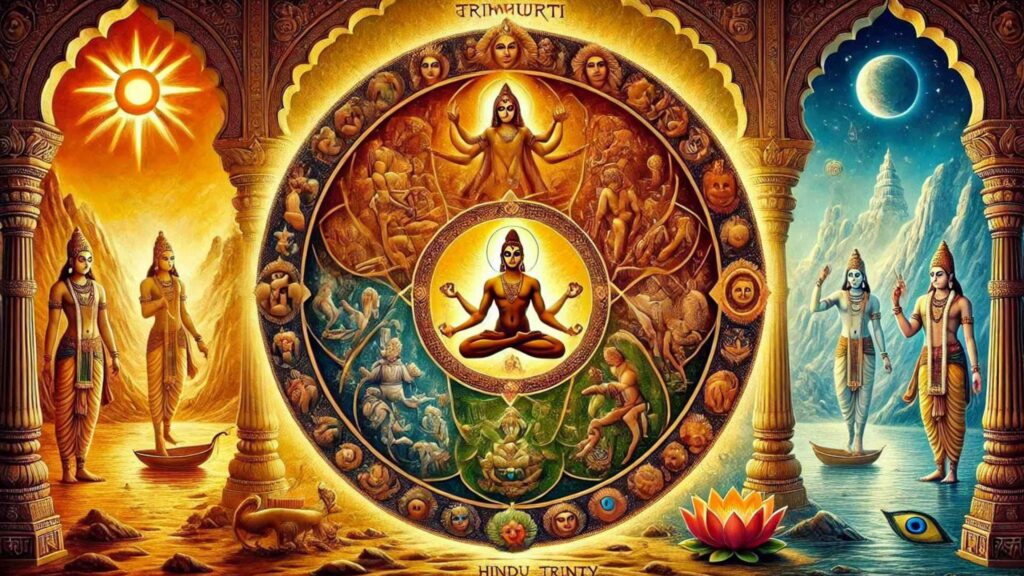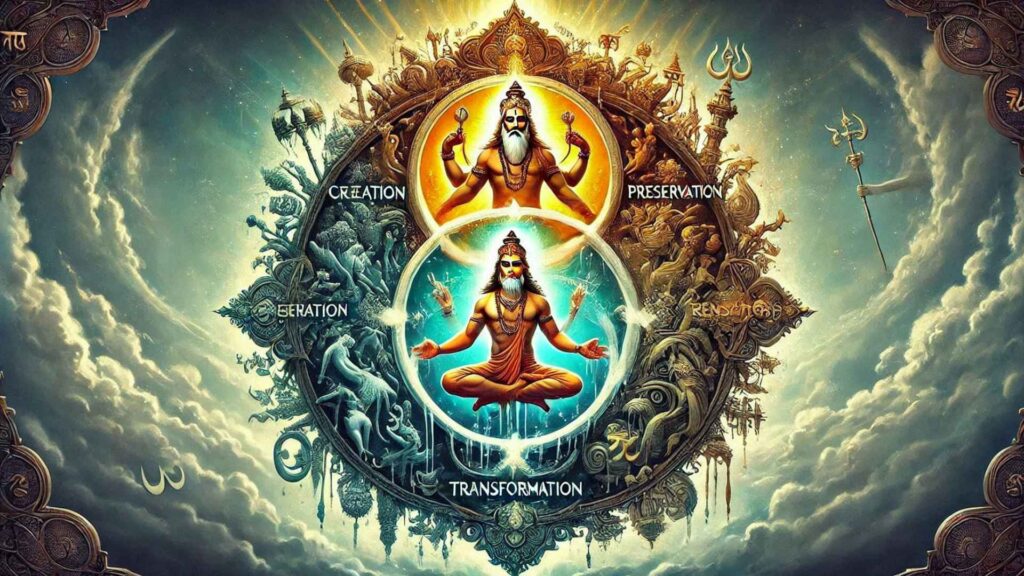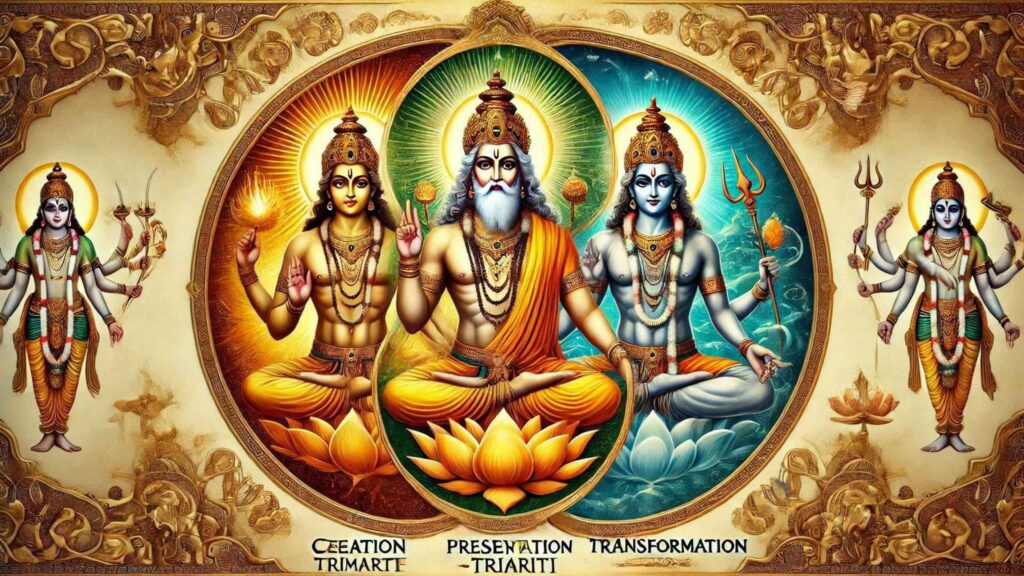Trimurti: The Divine Trinity in Hinduism
Introduction
Brief Overview of the Trimurti in Hinduism
The Trimurti, or the Hindu Trinity, represents the three fundamental aspects of the divine in Hindu philosophy: creation, preservation, and destruction. Comprised of Brahma (the creator), Vishnu (the preserver), and Shiva (the destroyer and regenerator), the Trimurti symbolizes the cyclical nature of the universe and its processes. This triad reflects the unified essence of ultimate reality, yet each deity embodies a distinct cosmic function.
Read More About Deities And Gods
Significance of the Trimurti in Daily Hindu Life
The Trimurti holds immense significance in daily worship and philosophy. Hindus invoke Brahma for creativity and knowledge, Vishnu for protection and sustenance, and Shiva for transformation and liberation. The concept underscores the interdependence of creation, preservation, and destruction in the natural and spiritual world.
Cosmic and Spiritual Importance
The Trimurti embodies the continuous cycle of birth, life, death, and rebirth that governs the universe. This trinity represents the supreme reality (Brahman) in its threefold aspect, showing how divine energy permeates and governs all existence.
Names and Etymology

Meaning of Trimurti
The term “Trimurti” is derived from the Sanskrit words Tri (three) and Murti (form), translating to “three forms.” It signifies the unified presence of Brahma, Vishnu, and Shiva as one supreme divine essence.
Other Names and Their Significance
- Trideva: The three gods, highlighting their equal importance in cosmic functions.
- Maheshwaras: Supreme beings, emphasizing their transcendental nature.
- Sanatana Devata: Eternal deities, representing the timeless aspects of the divine.
Each name reinforces the interconnectedness and holistic nature of the Trimurti.
Symbolism and Iconography

Physical Description and Its Meaning
The Trimurti is often depicted as a single body with three heads or three faces, symbolizing the unity of creation, preservation, and destruction. Alternatively, they are shown as separate deities, each with their unique attributes.
Symbolism
- Three Faces: Represent past, present, and future.
- Three Functions: Creation (Brahma), sustenance (Vishnu), and transformation (Shiva).
- Unity in Diversity: The Trimurti emphasizes harmony within different aspects of existence.
The Flower Connection
- Brahma: Associated with lotus flowers, symbolizing purity and creation.
- Vishnu: Connected to the tulsi plant, representing devotion and protection.
- Shiva: Linked to the bilva leaf, symbolizing regeneration and transformation.
Colors and Symbols Associated
- Colors: Gold (creation), blue (preservation), and white/ash gray (destruction).
- Symbols: The conch, discus, trident, and lotus are central in their iconography.
Mythology and Stories

Birth Story
The Trimurti represents the eternal cycle of cosmic functions and does not have a conventional birth story. However, the three deities are said to emanate from Brahman (the ultimate reality), each taking on a specific role in universal governance.
The Story of Creation and Cosmic Balance
According to the Puranas, Brahma creates the universe, Vishnu sustains it, and Shiva dissolves it when necessary, allowing for rebirth. This cycle ensures balance and the perpetual flow of cosmic energy.
Connection with Other Deities
- Brahma: Often linked to Saraswati, the goddess of wisdom and creativity.
- Vishnu: Associated with Lakshmi, the goddess of wealth and sustenance.
- Shiva: Paired with Parvati, the goddess of power and transformation.
Role in Ramayana and Mahabharata
- Ramayana: Vishnu incarnates as Rama, preserving dharma.
- Mahabharata: Krishna, another avatar of Vishnu, guides Arjuna, showcasing the importance of dharma and divine intervention.
Famous Blessings and Boons
The Trimurti collectively blesses humanity with creativity, sustenance, and the opportunity for renewal. Each deity grants boons aligning with their respective cosmic roles.
Spiritual Significance
A Visible Form of God
The Trimurti represents the visible forms of the unseen ultimate reality, making the abstract divine accessible to devotees.
Representation of Knowledge and Enlightenment
The Trimurti symbolizes the integration of knowledge (Brahma), ethical living (Vishnu), and transcendence (Shiva), leading to enlightenment.
Connection to Spiritual Awakening
Meditating on the Trimurti fosters inner balance and understanding of the cyclical nature of life, guiding individuals toward spiritual growth.
Role in Yoga and Meditation Practices
Each deity of the Trimurti represents a yogic principle:
- Brahma: Creativity and visualization (Jnana Yoga).
- Vishnu: Devotion and sustenance (Bhakti Yoga).
- Shiva: Transformation and detachment (Karma and Raja Yoga).
The Mantra Connection
- Trimurti Mantra:
“Om Brahmane Namah, Om Vishnave Namah, Om Shivaya Namah” – Invokes blessings from all three deities for balance and harmony.
Worship and Rituals
Benefits of Worship
Worshiping the Trimurti ensures holistic blessings, fostering creativity, sustenance, and spiritual transformation. It aligns devotees with the universal flow of energy.
Daily Worship Practices
- Offering flowers and incense to their idols or images.
- Chanting mantras that invoke the individual deities or the Trimurti collectively.
Best Times for Worship
- Brahma: Dawn, symbolizing creation and new beginnings.
- Vishnu: Noon, representing sustenance and growth.
- Shiva: Night, symbolizing reflection and transformation.
Significance of Day
- Sundays and full moon days are ideal for Trimurti worship, reflecting cosmic harmony.
Important Festivals
- Trimurti Jayanti: Celebrates the combined divinity of Brahma, Vishnu, and Shiva.
- Mahashivaratri: Dedicated to Shiva’s transformative energy.
- Diwali: Honors Vishnu’s role as the preserver through his incarnations.
List of Famous Temples
- Trimurti Temple, Khajuraho
- Elephanta Caves, Maharashtra
- Trimurti Mandir, Tamil Nadu
Modern Relevance
Scientific Understanding
The Trimurti’s cycle of creation, preservation, and destruction parallels scientific concepts like the Big Bang, entropy, and regeneration.
Environmental Consciousness
The Trimurti emphasizes the importance of balance, inspiring sustainable practices that align with the cycles of nature.
Health Benefits
Meditating on the Trimurti fosters mental clarity, emotional balance, and spiritual grounding, contributing to holistic well-being.
Energy Connection
The Trimurti symbolizes universal energy flow, encouraging individuals to align with the natural rhythms of creation, sustenance, and renewal.
Sustainable Living Practices
Their teachings inspire eco-friendly practices, mindful consumption, and reverence for life in all forms.
Cultural Impact
Influence on Indian Art and Architecture
The Trimurti’s imagery inspires temple architecture, sculptures, and classical art, showcasing its cultural and spiritual significance.
Presence in Literature and Poetry
Hymns like the Purusha Sukta and texts like the Puranas celebrate the Trimurti, highlighting their cosmic roles and philosophical importance.
Impact on Daily Customs
Daily prayers, rituals, and festivals dedicated to the Trimurti shape Hindu customs, fostering devotion and balance.
Regional Variations in Worship
The Trimurti’s worship varies across India, with temples and rituals emphasizing regional traditions and cultural interpretations.
Practical Applications
Morning Prayers and Rituals
Chanting Trimurti mantras at sunrise fosters creativity, clarity, and alignment with the divine.
Benefits of Salutation
Acknowledging the Trimurti instills gratitude, balance, and a holistic understanding of life’s cycles.
Dietary Recommendations
Observing vegetarianism during festivals or specific days of worship reflects the Trimurti’s emphasis on purity and balance.
Astrological Significance
The Trimurti’s worship mitigates the effects of planetary influences, fostering harmony in life.
Gemstones and Metals Associated
- Gemstones: Ruby (Brahma), Sapphire (Vishnu), and Moonstone (Shiva).
- Metals: Gold, silver, and copper, representing their respective energies.
Conclusion
Summary of Importance
The Trimurti, as the embodiment of creation, preservation, and destruction, provides a comprehensive framework for understanding the universe’s cycles and spiritual truths. Their teachings inspire balance, wisdom, and devotion.
Universal Message
The Trimurti reminds humanity of the interconnectedness of all aspects of life, urging us to embrace harmony, transformation, and spiritual growth.
Call to Action
Honor the Trimurti by aligning with their principles of creation, sustenance, and renewal, fostering balance and mindfulness in everyday life.


